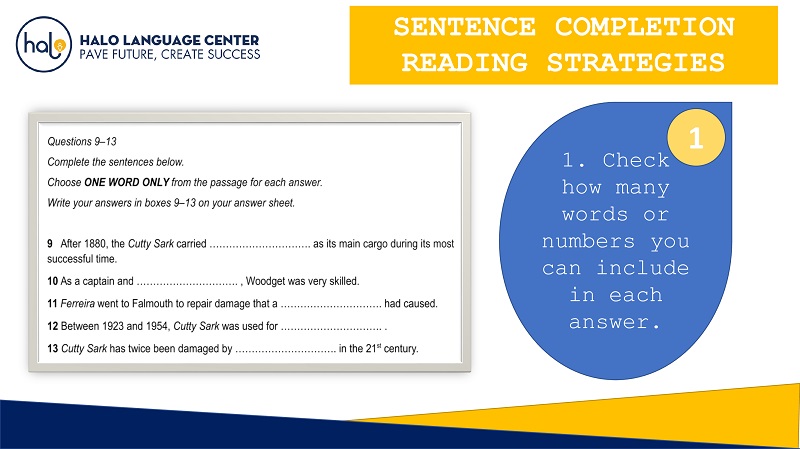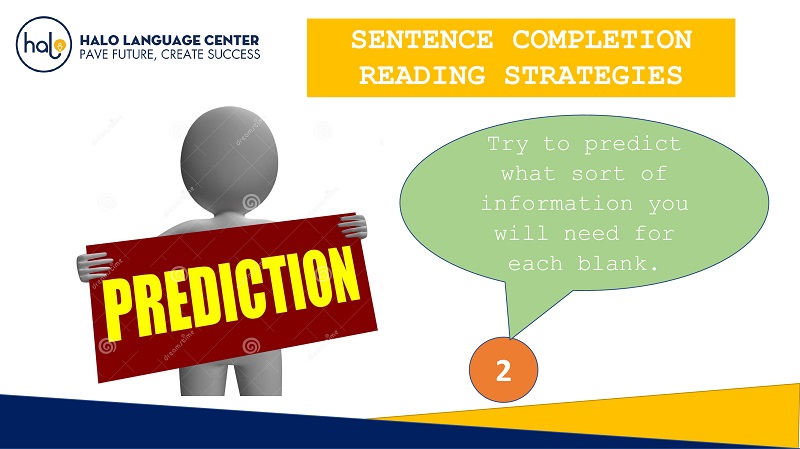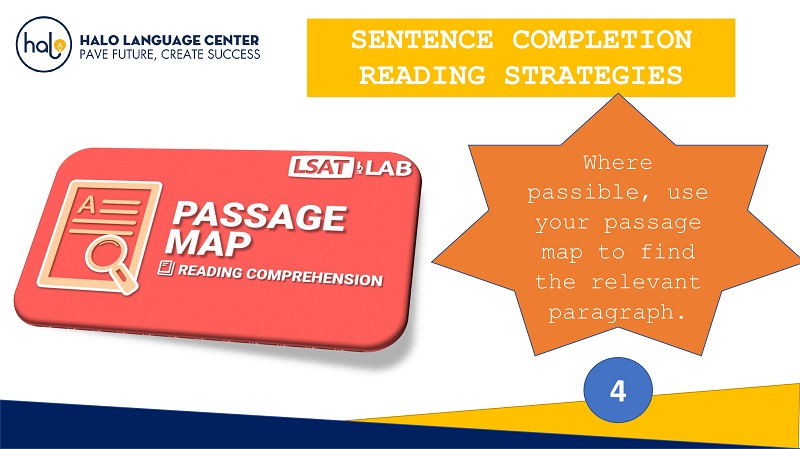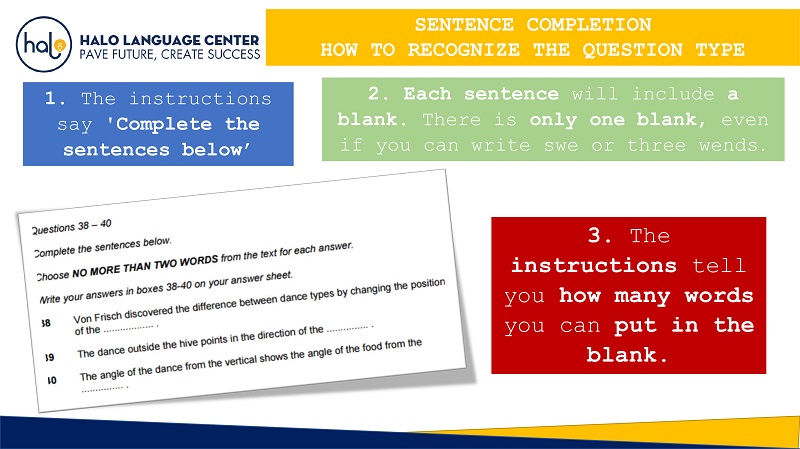IELTS Reading Sentence Completion Questions là dạng bài yêu cầu bạn hoàn thành một câu bằng cách chọn từ phù hợp trong một danh sách. Dạng bài này đòi hỏi thí sinh phải có vốn từ vựng phong phú, khả năng ngữ pháp tốt và kỹ năng suy luận logic. Cùng Halo tham khảo bài mẫu chi tiết bên dưới nhé
Sentence Completion Reading Strategies
1. Check how many words or numbers you can include in each answer.

2. Try to predict what sort of information you will need for each blank.

3. Check the wording before and after the blank, to ensure that your answer fits properly.

4. Where passible, use your passage map to find the relevant paragraph.

How to recognize the question type
1. The instructions say ‘Complete the sentences below’
2. Each sentence will include a blank. There is only one blank, even if you can write swe or three wends.
3. The instructions tell you how many words you can put in the blank.

Sentence Completion Improve Your Score
Practice by reading magazine articles on academic topics that appear frequently on the FELTS, such as business, science and history.
Good reading sources include The Economist (www.economist.com), New Scientist (www.newscientist.com) and BBC History Magazine (www.historyezira.com).

Pick an article of passage length (600-900 words) and make a passage map.
Time yourself. Practice until you can skim an article of this length and map it out in less than five minutes.

IELTS Reading Sentence Completion Sample Task
CALENDARS THROUGH THE YEARS
A. How many days are there in a year? You might say 365, with an extra ‘leap day’ added to the end of February every four years. This averages out to a quarter of a day every year, so that every year is 365.25 days. This is because the actual length of a solar year — that is, the time it takes for the Earth to complete a full rotation of the Sun — is a little bit more than 365 days. Throughout history, most calendars have tried to match their year to the length of a solar year, with varying degrees of accuracy.
B. The calendar used in much of the world today is based on the one used by the Romans. Because Romans thought that even numbers were unlucky, the earliest Roman calendar had months of 29 or 31 days, with 28 days in February. Since the year had 355 days, they would add a leap month of 27 days between February and March every 3 to 5 years, as determined by priests called pond fires. As a result, the average year was anywhere from 360 to 364 days, so it is no surprise that the calendar very quickly deviated from the solar year.
C. Julius Caesar decided that the calendar should be based on the solar year, following a special year of 445 days in 46 BC that readjusted the months to their proper seasons. From 45 BC onwards, the months were given the current lengths of 30 or 31 days, retaining 28 for February but adding the 29th February every four years to account for the accumulated extra quarter days. The names of the months used by the Romans remain in English today, either with a slight adjustment to spelling (e.g., they called it Aprilis, we call it April) or in the exact same form (e.g., they also called September, October, November and December by those very names).
D. The calendar used from 45 BC onwards — known as the Julian calendar, after the man who imposed it on the world — is far more accurate than any earlier calendar. Even so, the Julian calendar deviates from the solar year by 1 day every 128 years. This is because the exact length of the solar year is actually 365.2422 days, or about 11 minutes shorter than the 365.25 days calculated by the Romans.
E. By the 16th century AD, the discrepancy between the solar year and the Julian calendar was notable enough that something had to be done. It took several decades of consultation among mathematicians and astronomers until it was finally decided to end the Julian calendar, and move to a new system of calculating leap years. Pope Gregory XIII decreed that the Julian calendar would end on Thursday 4th October 1582, and that the following day would be Friday 15th October. This would remove the 10 days that had been added in error by the Julian system for leap years, and readjust the calendar to the seasons In the solar year.
F. The Gregorian calendar was put into use immediately in Italy, Portugal, Spain, Poland and most of France, and in Austria, Hungary and much of Germany in the next few years. However, the new calendar was not implemented by the United Kingdom and its overseas territories, such as the colonies that are known today as Canada and the United States, until 1752. By then, the adjustment required was 11 days, so the Parliament decided that the British would go to bed at the end of the day on 2nd September 1752 and wake up the next morning on 14th September. Sweden followed the British in moving to the Gregorian calendar the next year.
G. An even longer adjustment was required when the Gregorian calendar was adopted by Japan in 1872, and In the early 20th century by China, Bulgaria, Estonia, Russia, Greece and Turkey. Many of these countries that were among the last to adopt the Gregorian calendar for civic purposes used the Byzantine calendar, a variant of the Julian calendar, prior to the change. Many people in these same nations continue to use the Eastern Orthodox calendar (also based on the Julian calendar) for religious feasts and festivals. Similarly, in China and Japan, a traditional calendar is still used to select dates for weddings, funerals and new ventures. These last two countries did not exactly delay the move to the Gregorian calendar, rather, they started using it once it became beneficial, due to the more extensive connections with other countries on that calendar.
H. As we can see from this brief history of calendars, one of the key challenges in making any calendar is the decision about how to account for the variations between the calendar year and the solar year, since the latter includes a fraction of a day. The Gregorian calendar improved considerably on the Julian calendar, limiting the discrepancy to one day every 3,336 years. While it is commonly believed that every fourth year is a leap year, the actual rule imposed in 1582 is slightly more complicated. We add a day to February in years that are divisible by 4, but not in years divisible by 100, unless they can be divided by 400. Thus, 1700, 1800 and 1900 were not leap years, but 1600 and 2000 were. This adjustment means that the average calendar year is only 26 seconds longer than a solar year, so it won’t be an issue again until the year 4918.
Write NO MORE THAN THREE WORDS AN/OR A NUMBER for each answer.
8. A solar year is the time it takes for the Earth to make a …………. of the sun.
9. Without a …………. ,the year in the earliest Roman calendar was 355 days long.
10. From 45 BC, the calendar year was based on the solar year, thanks to the intervention of …………. .
11. Unfortunately, the solar year is …………. than the year in the Julian calendar.
12. When Pope Gregory XIII first instituted the new calendar, one change was to …………. that were mistakenly added by the Julian calendar.
13. The British used the Gregorian calendar starting in …………. .
14. Russia and other nations continue to use the …………. calendar for religious purposes.
15. Under current rules, years that are …………. are not leap years, unless they can also be divided evenly by 400.
Kết luận
Halo tin rằng với sự chuẩn bị kỹ lưỡng và luyện tập chăm chỉ, bạn hoàn toàn có thể nâng cao điểm số phần IELTS Reading. Hãy theo dõi Halo Language Center để cập nhật mọi tin tức mới nhất về kỳ thi IELTS nhé!
Cùng tham gia nhóm tự học IELTS 9.0 THỦ ĐỨC – QUẬN 9 để nhận thêm nhiều bộ tài liệu luyện thi IELTS miễn phí và nhận hỗ trợ giải đáp mọi thắc mắc về học tập và luyện đề IELTS từ giáo viên nhé !!!

